Nan Pu
Beyond Artificial Misalignment: Detecting and Grounding Semantic-Coordinated Multimodal Manipulations
Sep 16, 2025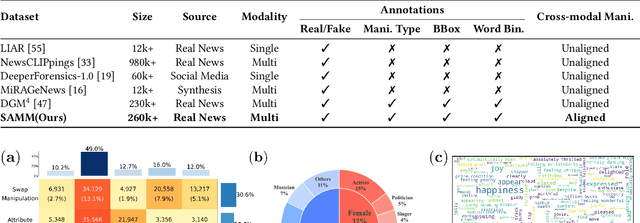



Abstract:The detection and grounding of manipulated content in multimodal data has emerged as a critical challenge in media forensics. While existing benchmarks demonstrate technical progress, they suffer from misalignment artifacts that poorly reflect real-world manipulation patterns: practical attacks typically maintain semantic consistency across modalities, whereas current datasets artificially disrupt cross-modal alignment, creating easily detectable anomalies. To bridge this gap, we pioneer the detection of semantically-coordinated manipulations where visual edits are systematically paired with semantically consistent textual descriptions. Our approach begins with constructing the first Semantic-Aligned Multimodal Manipulation (SAMM) dataset, generated through a two-stage pipeline: 1) applying state-of-the-art image manipulations, followed by 2) generation of contextually-plausible textual narratives that reinforce the visual deception. Building on this foundation, we propose a Retrieval-Augmented Manipulation Detection and Grounding (RamDG) framework. RamDG commences by harnessing external knowledge repositories to retrieve contextual evidence, which serves as the auxiliary texts and encoded together with the inputs through our image forgery grounding and deep manipulation detection modules to trace all manipulations. Extensive experiments demonstrate our framework significantly outperforms existing methods, achieving 2.06\% higher detection accuracy on SAMM compared to state-of-the-art approaches. The dataset and code are publicly available at https://github.com/shen8424/SAMM-RamDG-CAP.
Prototypical Hash Encoding for On-the-Fly Fine-Grained Category Discovery
Oct 24, 2024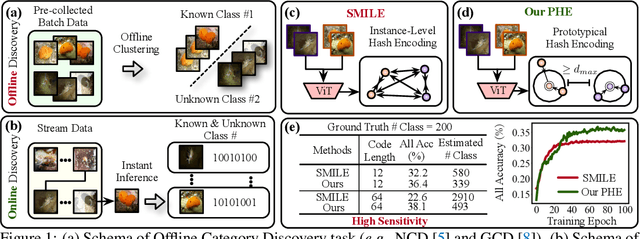


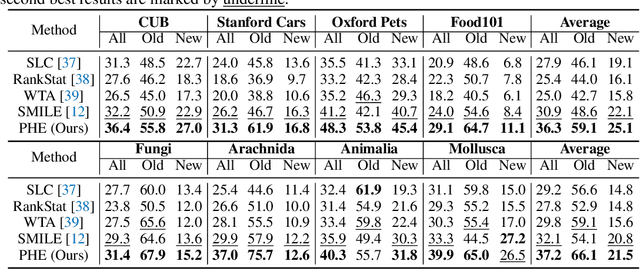
Abstract:In this paper, we study a practical yet challenging task, On-the-fly Category Discovery (OCD), aiming to online discover the newly-coming stream data that belong to both known and unknown classes, by leveraging only known category knowledge contained in labeled data. Previous OCD methods employ the hash-based technique to represent old/new categories by hash codes for instance-wise inference. However, directly mapping features into low-dimensional hash space not only inevitably damages the ability to distinguish classes and but also causes "high sensitivity" issue, especially for fine-grained classes, leading to inferior performance. To address these issues, we propose a novel Prototypical Hash Encoding (PHE) framework consisting of Category-aware Prototype Generation (CPG) and Discriminative Category Encoding (DCE) to mitigate the sensitivity of hash code while preserving rich discriminative information contained in high-dimension feature space, in a two-stage projection fashion. CPG enables the model to fully capture the intra-category diversity by representing each category with multiple prototypes. DCE boosts the discrimination ability of hash code with the guidance of the generated category prototypes and the constraint of minimum separation distance. By jointly optimizing CPG and DCE, we demonstrate that these two components are mutually beneficial towards an effective OCD. Extensive experiments show the significant superiority of our PHE over previous methods, e.g., obtaining an improvement of +5.3% in ALL ACC averaged on all datasets. Moreover, due to the nature of the interpretable prototypes, we visually analyze the underlying mechanism of how PHE helps group certain samples into either known or unknown categories. Code is available at https://github.com/HaiyangZheng/PHE.
Fire and Smoke Detection with Burning Intensity Representation
Oct 22, 2024



Abstract:An effective Fire and Smoke Detection (FSD) and analysis system is of paramount importance due to the destructive potential of fire disasters. However, many existing FSD methods directly employ generic object detection techniques without considering the transparency of fire and smoke, which leads to imprecise localization and reduces detection performance. To address this issue, a new Attentive Fire and Smoke Detection Model (a-FSDM) is proposed. This model not only retains the robust feature extraction and fusion capabilities of conventional detection algorithms but also redesigns the detection head specifically for transparent targets in FSD, termed the Attentive Transparency Detection Head (ATDH). In addition, Burning Intensity (BI) is introduced as a pivotal feature for fire-related downstream risk assessments in traditional FSD methodologies. Extensive experiments on multiple FSD datasets showcase the effectiveness and versatility of the proposed FSD model. The project is available at \href{https://xiaoyihan6.github.io/FSD/}{https://xiaoyihan6.github.io/FSD/}.
Benchmarking Multi-Scene Fire and Smoke Detection
Oct 22, 2024Abstract:The current irregularities in existing public Fire and Smoke Detection (FSD) datasets have become a bottleneck in the advancement of FSD technology. Upon in-depth analysis, we identify the core issue as the lack of standardized dataset construction, uniform evaluation systems, and clear performance benchmarks. To address this issue and drive innovation in FSD technology, we systematically gather diverse resources from public sources to create a more comprehensive and refined FSD benchmark. Additionally, recognizing the inadequate coverage of existing dataset scenes, we strategically expand scenes, relabel, and standardize existing public FSD datasets to ensure accuracy and consistency. We aim to establish a standardized, realistic, unified, and efficient FSD research platform that mirrors real-life scenes closely. Through our efforts, we aim to provide robust support for the breakthrough and development of FSD technology. The project is available at \href{https://xiaoyihan6.github.io/FSD/}{https://xiaoyihan6.github.io/FSD/}.
Discriminative Anchor Learning for Efficient Multi-view Clustering
Sep 25, 2024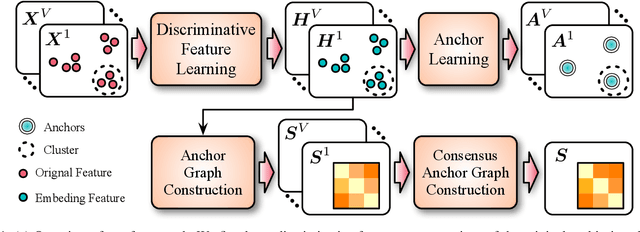
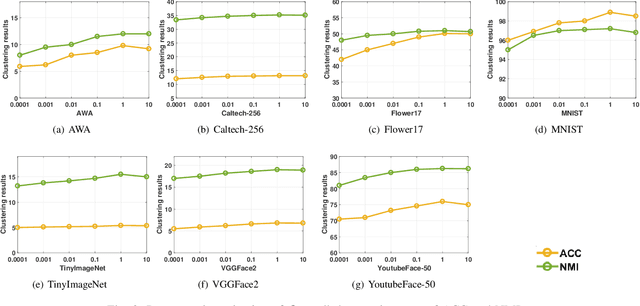
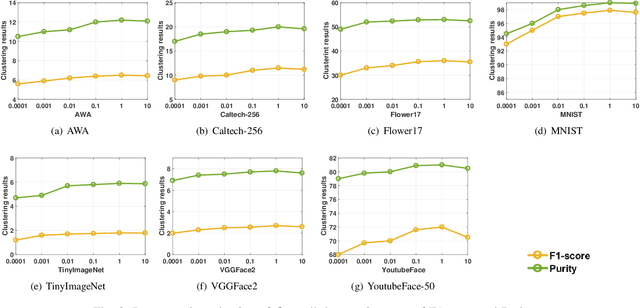
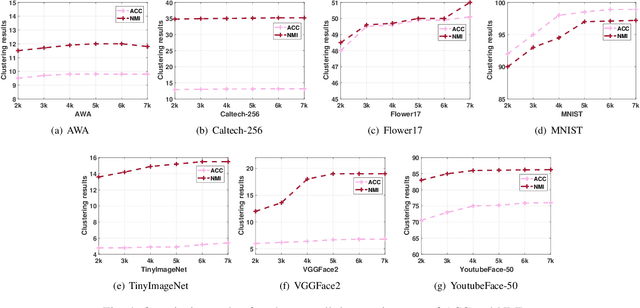
Abstract:Multi-view clustering aims to study the complementary information across views and discover the underlying structure. For solving the relatively high computational cost for the existing approaches, works based on anchor have been presented recently. Even with acceptable clustering performance, these methods tend to map the original representation from multiple views into a fixed shared graph based on the original dataset. However, most studies ignore the discriminative property of the learned anchors, which ruin the representation capability of the built model. Moreover, the complementary information among anchors across views is neglected to be ensured by simply learning the shared anchor graph without considering the quality of view-specific anchors. In this paper, we propose discriminative anchor learning for multi-view clustering (DALMC) for handling the above issues. We learn discriminative view-specific feature representations according to the original dataset and build anchors from different views based on these representations, which increase the quality of the shared anchor graph. The discriminative feature learning and consensus anchor graph construction are integrated into a unified framework to improve each other for realizing the refinement. The optimal anchors from multiple views and the consensus anchor graph are learned with the orthogonal constraints. We give an iterative algorithm to deal with the formulated problem. Extensive experiments on different datasets show the effectiveness and efficiency of our method compared with other methods.
Novel Class Discovery for Ultra-Fine-Grained Visual Categorization
May 10, 2024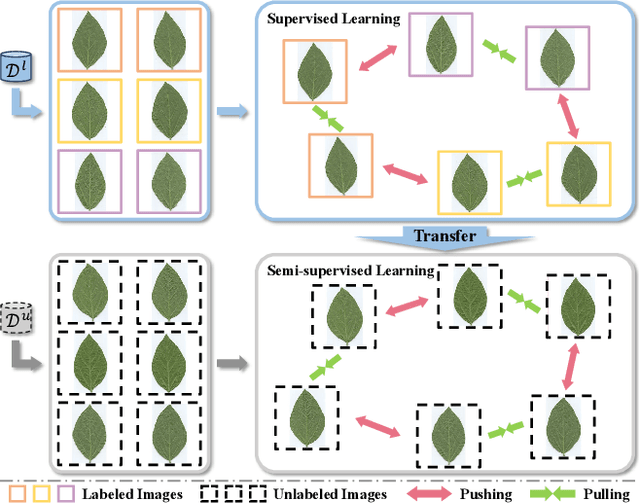


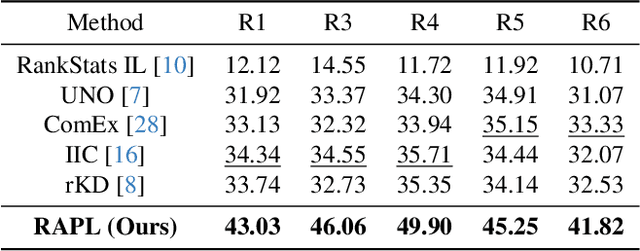
Abstract:Ultra-fine-grained visual categorization (Ultra-FGVC) aims at distinguishing highly similar sub-categories within fine-grained objects, such as different soybean cultivars. Compared to traditional fine-grained visual categorization, Ultra-FGVC encounters more hurdles due to the small inter-class and large intra-class variation. Given these challenges, relying on human annotation for Ultra-FGVC is impractical. To this end, our work introduces a novel task termed Ultra-Fine-Grained Novel Class Discovery (UFG-NCD), which leverages partially annotated data to identify new categories of unlabeled images for Ultra-FGVC. To tackle this problem, we devise a Region-Aligned Proxy Learning (RAPL) framework, which comprises a Channel-wise Region Alignment (CRA) module and a Semi-Supervised Proxy Learning (SemiPL) strategy. The CRA module is designed to extract and utilize discriminative features from local regions, facilitating knowledge transfer from labeled to unlabeled classes. Furthermore, SemiPL strengthens representation learning and knowledge transfer with proxy-guided supervised learning and proxy-guided contrastive learning. Such techniques leverage class distribution information in the embedding space, improving the mining of subtle differences between labeled and unlabeled ultra-fine-grained classes. Extensive experiments demonstrate that RAPL significantly outperforms baselines across various datasets, indicating its effectiveness in handling the challenges of UFG-NCD. Code is available at https://github.com/SSDUT-Caiyq/UFG-NCD.
Textual Knowledge Matters: Cross-Modality Co-Teaching for Generalized Visual Class Discovery
Mar 12, 2024Abstract:In this paper, we study the problem of Generalized Category Discovery (GCD), which aims to cluster unlabeled data from both known and unknown categories using the knowledge of labeled data from known categories. Current GCD methods rely on only visual cues, which however neglect the multi-modality perceptive nature of human cognitive processes in discovering novel visual categories. To address this, we propose a two-phase TextGCD framework to accomplish multi-modality GCD by exploiting powerful Visual-Language Models. TextGCD mainly includes a retrieval-based text generation (RTG) phase and a cross-modality co-teaching (CCT) phase. First, RTG constructs a visual lexicon using category tags from diverse datasets and attributes from Large Language Models, generating descriptive texts for images in a retrieval manner. Second, CCT leverages disparities between textual and visual modalities to foster mutual learning, thereby enhancing visual GCD. In addition, we design an adaptive class aligning strategy to ensure the alignment of category perceptions between modalities as well as a soft-voting mechanism to integrate multi-modality cues. Experiments on eight datasets show the large superiority of our approach over state-of-the-art methods. Notably, our approach outperforms the best competitor, by 7.7% and 10.8% in All accuracy on ImageNet-1k and CUB, respectively.
Federated Generalized Category Discovery
May 23, 2023



Abstract:Generalized category discovery (GCD) aims at grouping unlabeled samples from known and unknown classes, given labeled data of known classes. To meet the recent decentralization trend in the community, we introduce a practical yet challenging task, namely Federated GCD (Fed-GCD), where the training data are distributively stored in local clients and cannot be shared among clients. The goal of Fed-GCD is to train a generic GCD model by client collaboration under the privacy-protected constraint. The Fed-GCD leads to two challenges: 1) representation degradation caused by training each client model with fewer data than centralized GCD learning, and 2) highly heterogeneous label spaces across different clients. To this end, we propose a novel Associated Gaussian Contrastive Learning (AGCL) framework based on learnable GMMs, which consists of a Client Semantics Association (CSA) and a global-local GMM Contrastive Learning (GCL). On the server, CSA aggregates the heterogeneous categories of local-client GMMs to generate a global GMM containing more comprehensive category knowledge. On each client, GCL builds class-level contrastive learning with both local and global GMMs. The local GCL learns robust representation with limited local data. The global GCL encourages the model to produce more discriminative representation with the comprehensive category relationships that may not exist in local data. We build a benchmark based on six visual datasets to facilitate the study of Fed-GCD. Extensive experiments show that our AGCL outperforms the FedAvg-based baseline on all datasets.
Dynamic Conceptional Contrastive Learning for Generalized Category Discovery
Mar 30, 2023



Abstract:Generalized category discovery (GCD) is a recently proposed open-world problem, which aims to automatically cluster partially labeled data. The main challenge is that the unlabeled data contain instances that are not only from known categories of the labeled data but also from novel categories. This leads traditional novel category discovery (NCD) methods to be incapacitated for GCD, due to their assumption of unlabeled data are only from novel categories. One effective way for GCD is applying self-supervised learning to learn discriminate representation for unlabeled data. However, this manner largely ignores underlying relationships between instances of the same concepts (e.g., class, super-class, and sub-class), which results in inferior representation learning. In this paper, we propose a Dynamic Conceptional Contrastive Learning (DCCL) framework, which can effectively improve clustering accuracy by alternately estimating underlying visual conceptions and learning conceptional representation. In addition, we design a dynamic conception generation and update mechanism, which is able to ensure consistent conception learning and thus further facilitate the optimization of DCCL. Extensive experiments show that DCCL achieves new state-of-the-art performances on six generic and fine-grained visual recognition datasets, especially on fine-grained ones. For example, our method significantly surpasses the best competitor by 16.2% on the new classes for the CUB-200 dataset. Code is available at https://github.com/TPCD/DCCL.
Lifelong Person Re-Identification via Adaptive Knowledge Accumulation
Mar 23, 2021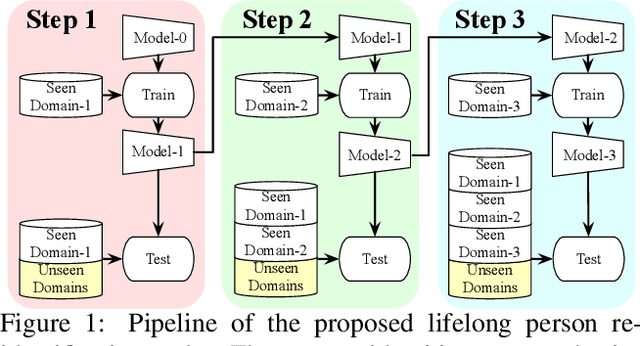
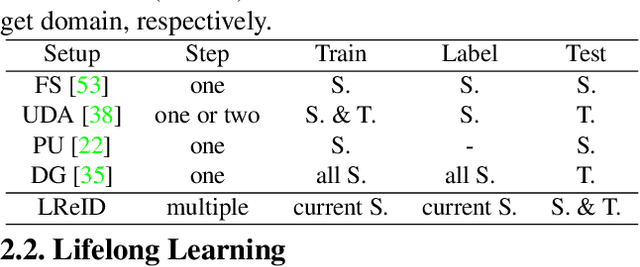


Abstract:Person ReID methods always learn through a stationary domain that is fixed by the choice of a given dataset. In many contexts (e.g., lifelong learning), those methods are ineffective because the domain is continually changing in which case incremental learning over multiple domains is required potentially. In this work we explore a new and challenging ReID task, namely lifelong person re-identification (LReID), which enables to learn continuously across multiple domains and even generalise on new and unseen domains. Following the cognitive processes in the human brain, we design an Adaptive Knowledge Accumulation (AKA) framework that is endowed with two crucial abilities: knowledge representation and knowledge operation. Our method alleviates catastrophic forgetting on seen domains and demonstrates the ability to generalize to unseen domains. Correspondingly, we also provide a new and large-scale benchmark for LReID. Extensive experiments demonstrate our method outperforms other competitors by a margin of 5.8% mAP in generalising evaluation.
 Add to Chrome
Add to Chrome Add to Firefox
Add to Firefox Add to Edge
Add to Edge